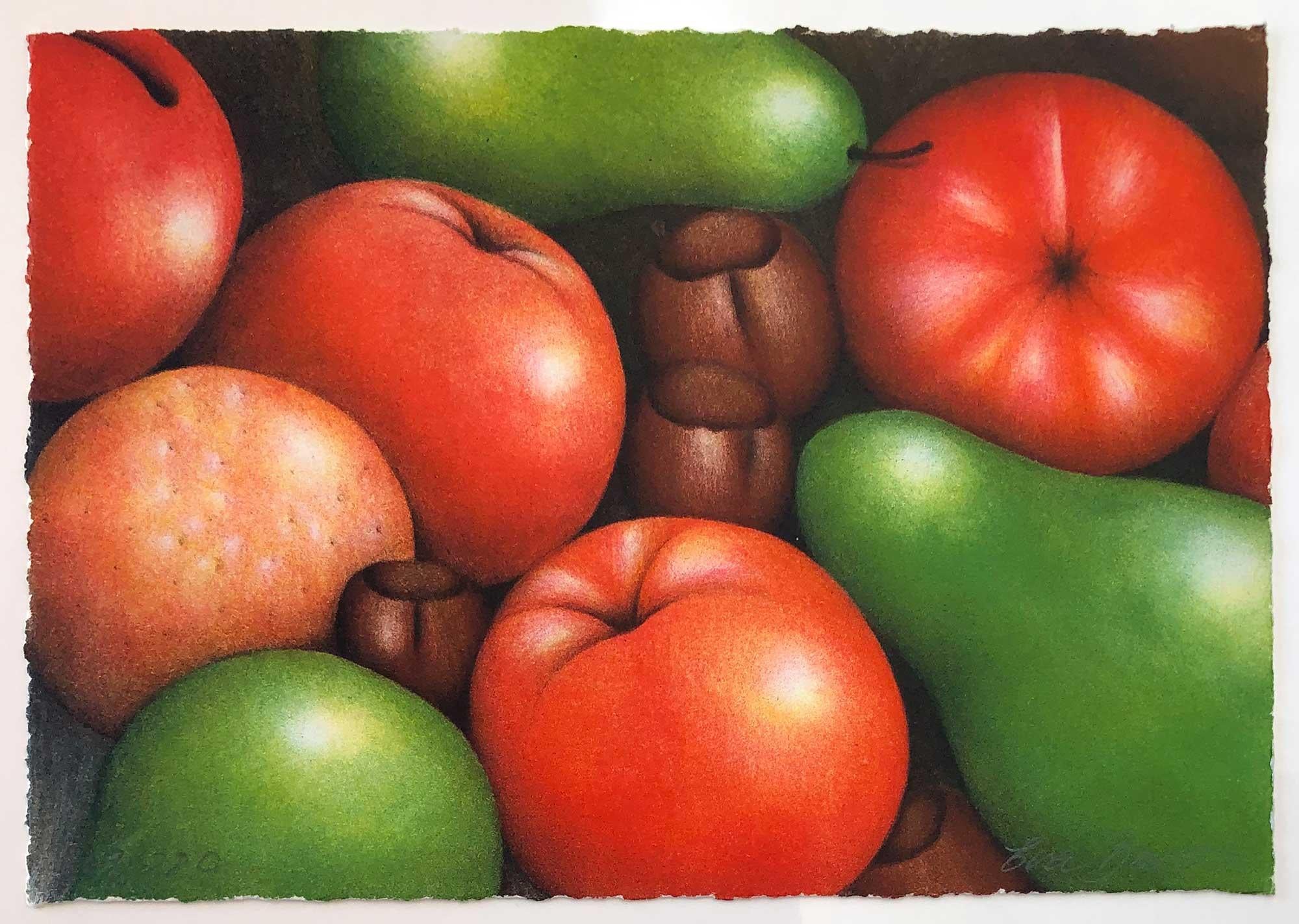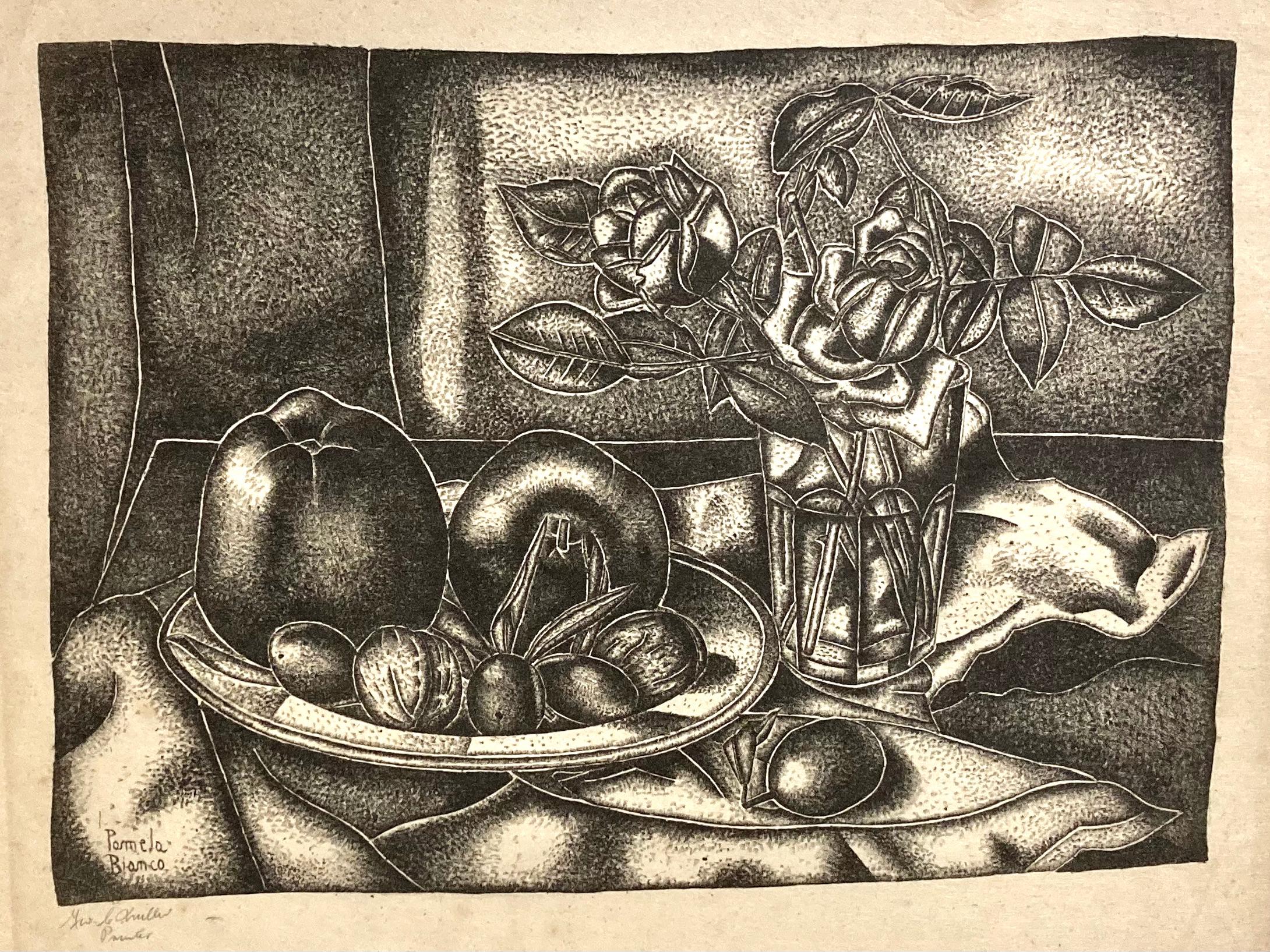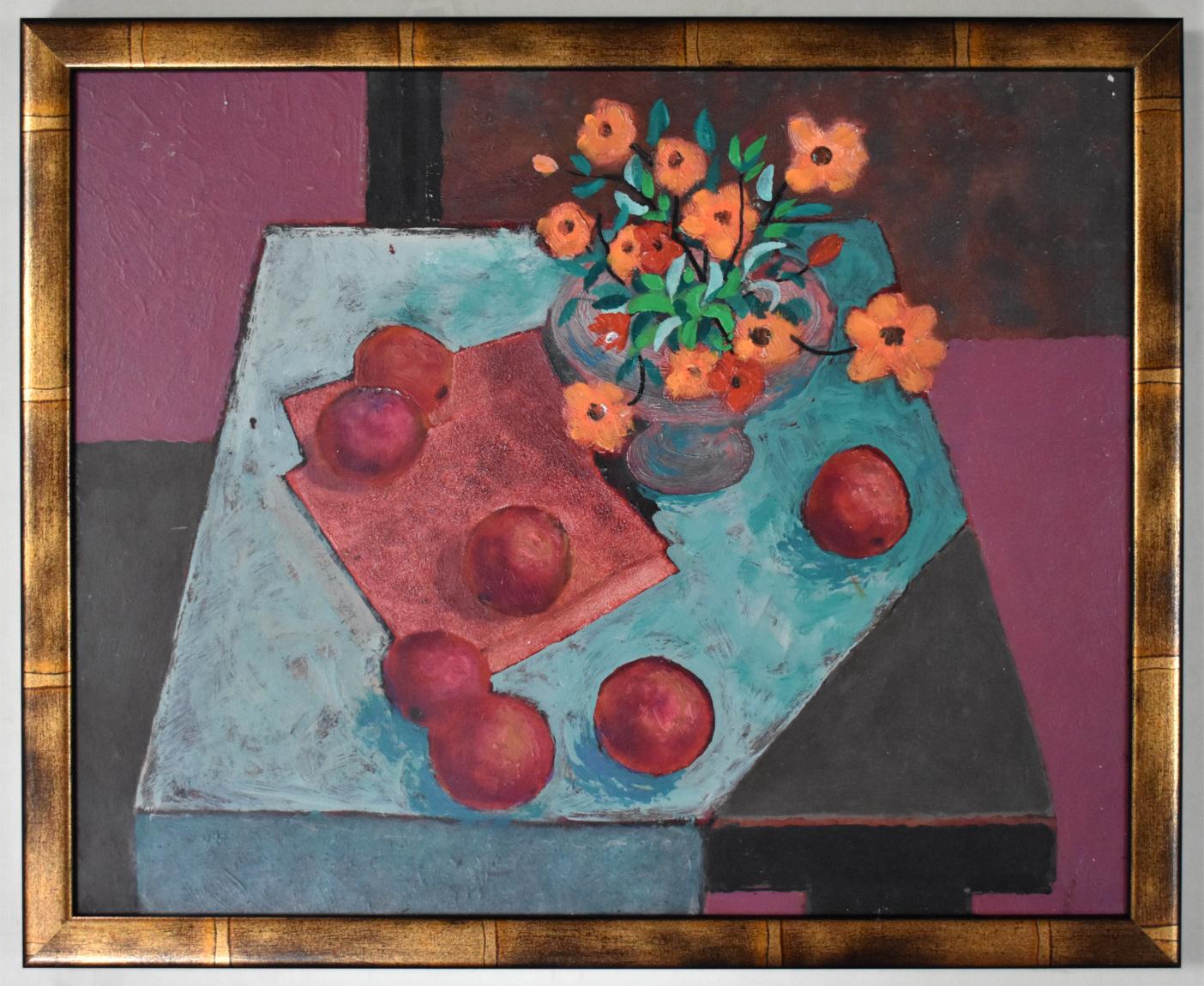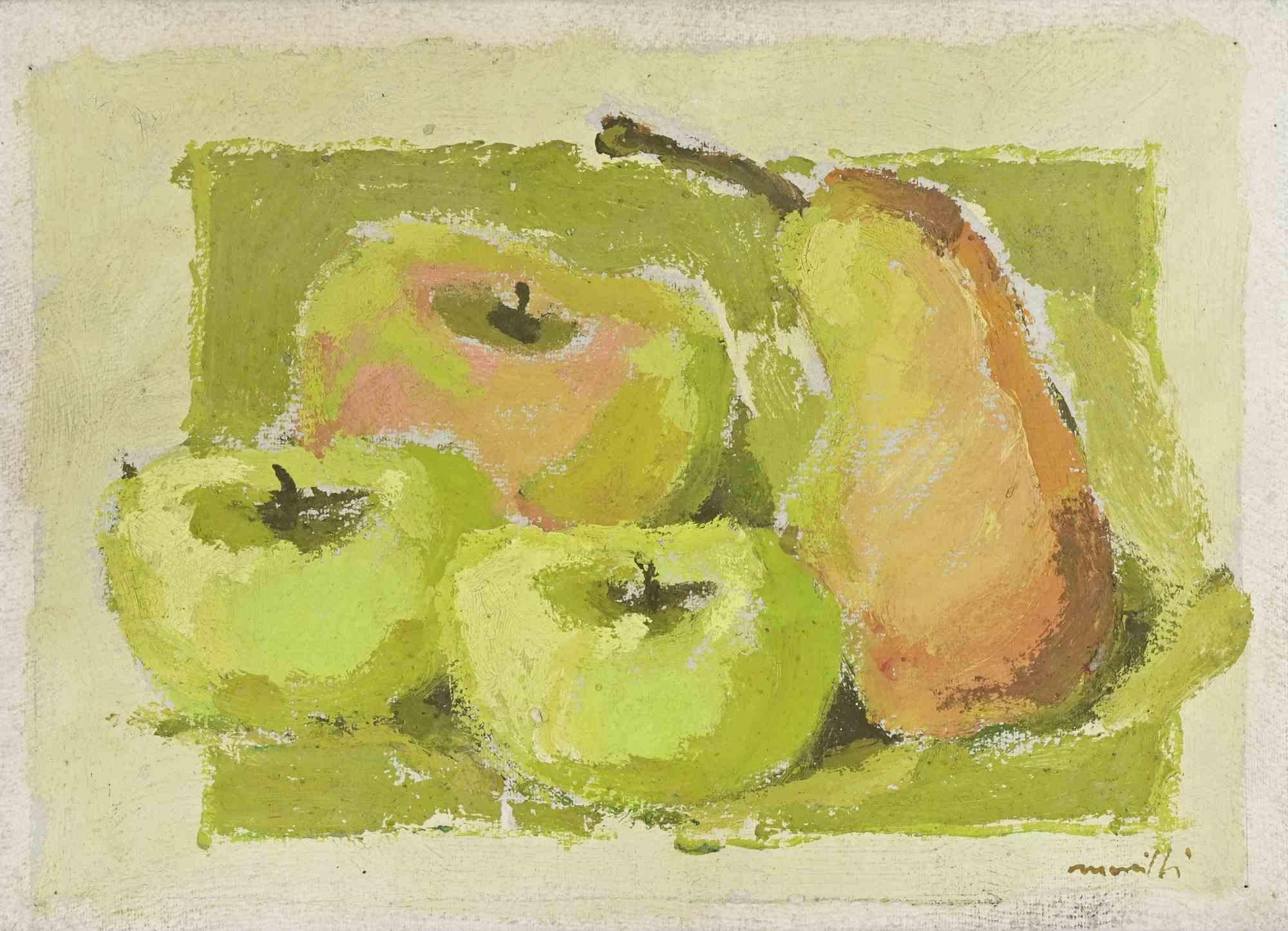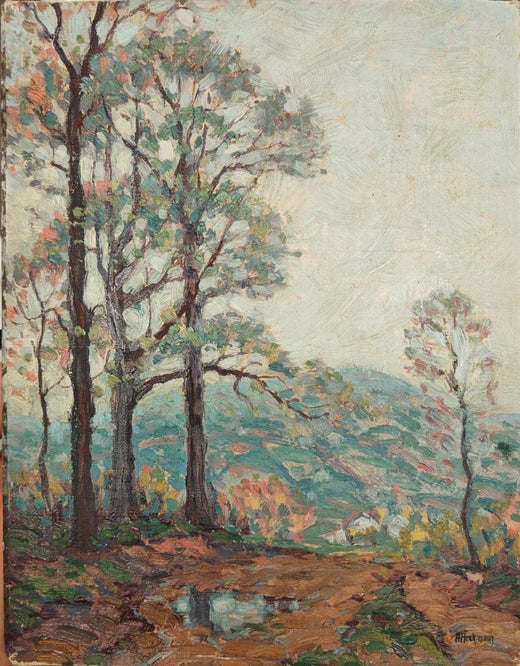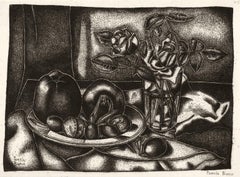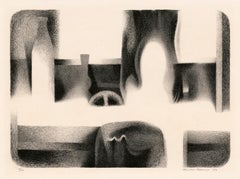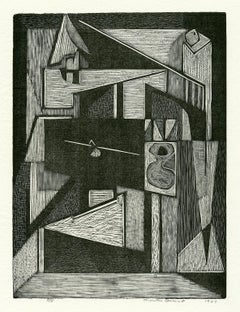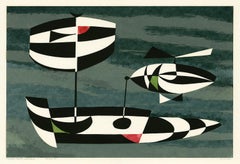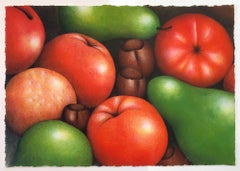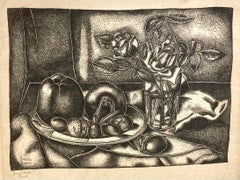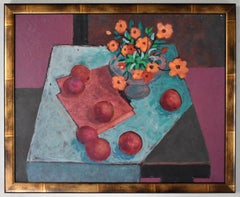Items Similar to 'Fruit Forms' — American Modernism
Want more images or videos?
Request additional images or videos from the seller
1 of 3
Albert Heckman'Fruit Forms' — American Modernismc. 1935
c. 1935
$850
£654.74
€747.64
CA$1,212.72
A$1,327.11
CHF 696.01
MX$15,861.77
NOK 8,783.58
SEK 8,194.02
DKK 5,583.48
About the Item
Albert Heckman, 'Fruit Forms', color lithograph, edition not stated, c. 1935. Signed and titled in pencil. A fine, richly-inked impression, with fresh colors, on cream, wove paper; the full sheet with margins (2 1/2 to 3 inches); the printer's color registration pinholes in the center, left and right margins, away from the image, in excellent condition. Image size 9 1/2 x 16 inches (241 x 406 mm); sheet size 15 x 21 inches (381 x 533 mm). Matted to museum standards, unframed.
Collection: Whitney Museum of American Art.
ABOUT THE ARTIST
Painter, etcher, lithographer, designer, and lecturer, Albert Heckman (1893-1971) was born in Pennsylvania and studied at Columbia University in New York City. Heckman divided his time between New York and Woodstock, teaching at Hunter College from 1930 to 1958, and at the Woodstock Teachers College Summer School in the 1930s.
Heckman exhibited at the Society of Independent Artists, New York Watercolor Society, The Philadelphia Print Club, Art Institute of Chicago, and the Philadelphia Academy of Fine Art. His work was shown at the Whitney Biennial in 1933 and 1936, and at the Whitney Museum of American Art’s Annual Exhibition of Contemporary American Sculpture, Watercolors and Drawings in 1948, 1949, 1951, 1952, 1953, and 1956.
Heckman’s work is included in the institutional collections of the Brooks Museum, Krannert Art Museum, Library of Congress, National Gallery of Art, Philadelphia Museum of Art, San José Museum of Art, Smithsonian American Art Museum, Whitney Museum of American Art, and the Woodstock Art Association.
- Creator:Albert Heckman (1893-1971, American)
- Creation Year:c. 1935
- Dimensions:Height: 9.5 in (24.13 cm)Width: 16 in (40.64 cm)
- Medium:
- Movement & Style:
- Period:
- Condition:
- Gallery Location:Myrtle Beach, SC
- Reference Number:Seller: 1035341stDibs: LU532310821252
Albert Heckman
Born in Meadville, Pennsylvania, Heckman came to NYC in 1915 and divided his time between there and Woodstock for the rest of his life except for 1929, when he studied in Leipzig. Married to concert violinist Florence Hardeman. Position: teacher, Hunter College, 1930-58; Teachers College Summer School, Woodstock, 1930s. Author: Paintings of Many Lands and Ages. He was a member of the Woodstock Art Association; and was also part of the Works Progress Administration Federal Arts Program in New York City, doing etching and block printing. He was influenced by Cubism and Expressionism.
About the Seller
5.0
Recognized Seller
These prestigious sellers are industry leaders and represent the highest echelon for item quality and design.
Platinum Seller
Premium sellers with a 4.7+ rating and 24-hour response times
Established in 1995
1stDibs seller since 2016
333 sales on 1stDibs
Typical response time: 1 hour
Associations
International Fine Print Dealers Association
- ShippingRetrieving quote...Shipping from: Myrtle Beach, SC
- Return Policy
More From This Seller
View All'Fruit Piece' — American Modernism, Woman Artist
Located in Myrtle Beach, SC
Pamela Bianco, 'Fruit Piece', lithograph, c. 1925. Signed and titled in pencil. Signed in the stone, lower left. Annotated 'No. 8' in pencil, upper right...
Category
1920s American Modern Figurative Prints
Materials
Lithograph
'September Still Life' — Mid-Century Modernism
By Clinton Adams
Located in Myrtle Beach, SC
Clinton Adams, 'September Still Life', lithograph, 1956, edition 20. A superb impression, on cream wove paper, with full margins (1 1/2 to 3 1/8 inches);...
Category
1950s American Modern Still-life Prints
Materials
Lithograph
Still Life — Mid-century Modern
By Charles Quest
Located in Myrtle Beach, SC
Charles Quest, 'Still Life', 1947, wood engraving, edition 8. Signed, dated, and numbered '3/8' in pencil. Titled and annotated 'wood engraving' in the bottom left margin. A fine impression, on off-white wove paper, with full margins (1 to 2 inches), in excellent condition. Scarce. Matted to museum standards, unframed.
ABOUT THE ARTIST
Charles Quest, painter, printmaker, and fine art instructor, worked in various mediums, including mosaic, stained glass, mural painting, and sculpture. Quest grew up in St. Louis, his talent evident as a teenager when he began copying the works of masters such as Michelangelo on his bedroom walls. He studied at the Washington University School of Fine Arts, where he later taught from 1944 to 1971. He traveled to Europe after his graduation in 1929 and studied at La Grande Chaumière and Academie Colarossi, Paris, continuing to draw inspiration from the works of the Old Masters.
After returning to St. Louis, Quest received several commissions to paint murals in public buildings, schools, and churches, including one from Joseph Cardinal Ritter, to paint a replica of Velasquez's Crucifixion over the main altar of the Old Cathedral in St. Louis. Quest soon became interested in the woodcut medium, which he learned through his study of J. J. Lankes' A Woodcut Manual (1932) and Paul Landacre's articles in American Artist magazine ‘since no artists in St. Louis were working in wood’ at that time. Quest also revealed that for him, wood cutting and engraving were ‘more enjoyable than any other means of expression.’
In the late 1940s, his graphic works began attracting critical attention—several of his woodcuts won prizes and were acquired by major American and European museums. His wood engraving entitled ‘Lovers’ was included in the American Federation of Art's traveling print exhibition in 1947. Two years later, Quest's two prize-winning prints, ‘Still Life with Grindstone’ and ‘Break Forth into Singing’, were exhibited in major American museums in a traveling show organized by the Philadelphia Print Club. His work was included in the Chicago Art Institute's exhibition, ‘Woodcut Through Six Centuries’, and the print ‘Still Life with Vise’ was purchased by the Museum of Modern Art in New York.
In 1951 he was invited by artist-Curator Jacob Kainen to exhibit thirty wood engravings and color woodcuts in a one-person show at the Smithsonian's National Museum (now known as the American History Museum). Kainen's press release praised the ‘technical refinement’ of Quest's work: ‘He obtains a great variety of textural effects through the use of the graver, and these dense or transparent grays are set off against whites or blacks to achieve sparkling results. His work has the handsome qualities characteristic of the craftsman and designer.’
At the time of the Smithsonian exhibition, Quest's work was represented by three New York galleries in addition to one in his home town. He had won 38 prizes, and his prints were in the collections of the Library of Congress, the Chicago Art Institute, the Metropolitan Museum, and the Philadelphia Museum of Art. In cooperation with the Art in Embassies program, his color woodcuts were displayed at the American Embassy in Paris in 1951.
Recognition at home came in 1955 with his first solo exhibition in St. Louis. Press coverage of the show heralded the ‘growth of graphic arts toward rivaling painting and sculpture as a major independent medium’.
An exhibition of his prints at the Bethesda Art Gallery in 1983 attracted Curator Emeritus Joseph A. Haller, S.J., who began purchasing his work for Georgetown University's collection. In 1990 Georgetown University Library's Special Collections Division was the recipient of a large body of Quest's work, including prints, drawings, paintings, sculpture, stained glass, and his archive of correspondence and professional memorabilia. These extensive holdings, including some 260 of his fine prints, provide a rich opportunity for further study and appreciation of this versatile and not-to-be-forgotten mid-Western American artist...
Category
1940s American Modern Abstract Prints
Materials
Woodcut
'Flyable Objects Identified' — Mid-Century Modernism
By Edward August Landon
Located in Myrtle Beach, SC
Edward Landon, 'Flyable Objects Identified', color serigraph, 1969, edition 30, Ryan 83. Signed, titled, and annotated 'Edition 30' in pencil. A fine impression, with fresh colors, o...
Category
Mid-20th Century American Modern Abstract Prints
Materials
Screen
'Salient in February' — Mid 20th-Century Surrealism
By Edward August Landon
Located in Myrtle Beach, SC
Edward Landon 'Salient in February', color serigraph, 1945, edition 40, Ryan 166. Signed in pencil. Titled, dated, and annotated 'ED. 40' in pencil. A fine impression, with fresh col...
Category
Mid-20th Century Surrealist Abstract Prints
Materials
Screen
'#9' — Modernist Abstraction — African American Artist
Located in Myrtle Beach, SC
Hilliard Dean, '#9', color lithograph, 1970, edition 7. Signed, titled, and annotated 'Ed 7' in pencil. A fine impression, with fresh colors, on Arches, ...
Category
1970s Contemporary Abstract Prints
Materials
Lithograph
You May Also Like
Untitled (fruit)
By Eva Bostrom
Located in Palm Springs, CA
Signed and numbered lithograph from the edition of 250. Medley of pears, tomatoes and potatoes. A whole series of different fruits and vegetables from this series are available.
Ev...
Category
21st Century and Contemporary Contemporary Still-life Prints
Materials
Lithograph
Still life - Fruits, pears and apples - Lithograph, 1971
By Paul Cézanne
Located in Paris, IDF
Paul Cezanne
The green jug, 1971
Lithograph and stencil (Jacomet workshop)
Unsigned
Numbered / 225
On paper applied on Arches vellum 41.5 x 53.5 cm (c. 16.5 x 21 in)
INFORMATION : ...
Category
1970s Modern Still-life Prints
Materials
Lithograph, Stencil
Pamela Bianco, Fruit Piece
Located in New York, NY
Pamela Bianco achieve success as an artist in Britain while still a child. This accomplishment resulted in the family coming to the United States where ...
Category
1920s American Modern Still-life Prints
Materials
Lithograph
"STILL LIFE FRUIT" MID CENTURY
By Michael Frary
Located in San Antonio, TX
Michael Frary
(1918 - 2005)
Austin Artist
Image Size: 16 x 20
Frame Size: 17.5 x 21.5
Medium: Oil
"Still Life Fruit"
Biography
Michael Frary (1918 - ...
Category
1960s American Modern Still-life Paintings
Materials
Oil
Still Life with Fruit - Oil Painting by Franco Marzilli - 1970s
By Franco Marzilli
Located in Roma, IT
Oil on canvas realized by Franco Marzilli (1934-2010) in 1970s.
Hand signed lower right.
Very good condition.
Franco Marzilli was born in Rome in 1934. He received his first artis...
Category
1970s Contemporary Figurative Paintings
Materials
Oil
$520 Sale Price
20% Off
Fruit-Poster. 1956 New York Graphic Society, Ltd. Printed in Switzerland
By James Peale Sr.
Located in Chesterfield, MI
JAMES PEALE (American, 1749-1831)
Poster
22.75 x 31 in. Unframed
1956 Copyright New York Graphic Society, Ltd. Printed in Switzerland.
Fair/Distressed Condition-indentation, disc...
Category
1950s Still-life Prints
Materials
Lithograph
More Ways To Browse
Vintage Fruit
Jonas Wood Large Shelf Still Life
Les Diners De Gala
Salvador Dali Les Diners De Gala
Vintage Magnolia Prints
Wayne Thiebaud Etching
Yayoi Kusama Signed
Gina Lombardi
Great Exhibition 1851
Peter Max Vase Of Flowers
Vintage Cyanotypes
W Rees
Andy Warhol Flowers 1970
Antique Ballet Slippers
Connecticut Barns
David Hockney A Bigger Book
Donald Sultan Wallflowers
Karl Kasten
